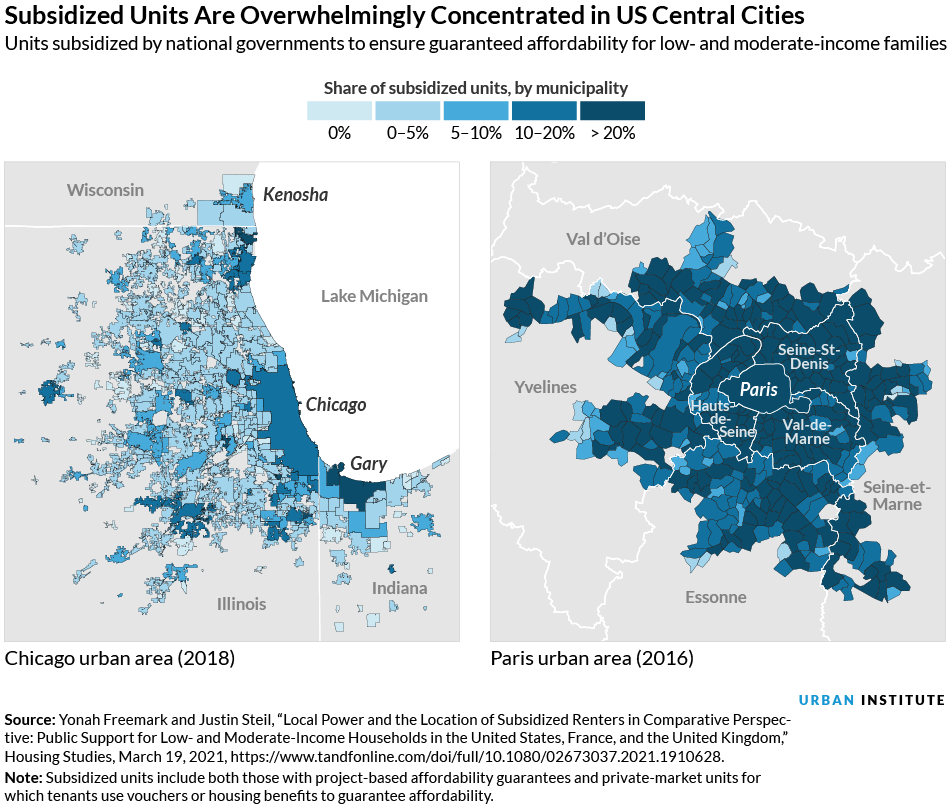
<p>(oversnap / Getty Images)</p>
About 30 million households with low incomes pay more than 30 percent of their incomes to rent, and about 10 million pay more than 50 percent in the United States. High housing costs limit many people’s ability to find safe, affordable, and quality homes in desirable neighborhoods. For households with low incomes, it’s even harder.
The affordable housing crisis stems from an insufficient number of affordable housing units (despite the availability of several million government-assisted units nationwide, many families with low incomes in every county are cost burdened) and uneven distribution of affordable housing. Households with low incomes are often denied opportunities to live in communities of their choice because of high market-rate housing prices and policies designed to keep them out, such as rules prohibiting apartment construction.
The lack of affordable housing and the inability of households to effectively choose their neighborhood hinder the health, educational, and economic outcomes of families with low incomes and reduce social mobility overall.
Government decisions about how much affordable housing is provided and where it is located influence the life trajectories of children in families with low incomes. Our new research explores how affordable housing conditions in the largest US urban areas compare with those in France and the United Kingdom. We found US renters have a harder time affording and accessing housing than their European counterparts and point to several ways US policymakers could implement lessons from overseas. This work builds on our recent research comparing how the structure of local government powers and resources varies dramatically by both nation and region in ways that can attenuate or exacerbate spatial dimensions of inequality.
Affordable housing is underprovided in the largest US metropolitan areas
In the United States, the federal government provides subsidies to guarantee that certain rental housing is affordable to families with low and moderate incomes. These subsidies come in two basic forms: project-based support that lowers the cost of units (including public housing, project-based Section 8, and Low-Income Housing Tax Credit units) and tenant-based support that reduces the cost to rent in private-market units (generally through the Housing Choice Voucher Program). In both cases, families can only receive subsidies if they fall under a maximum income level.
How available are federal affordable housing subsidies in the largest US urban areas, and how do they compare with conditions in other countries?
We examined this question by quantifying project-based and tenant-based housing support in the Chicago, Los Angeles, and New York metropolitan areas—and comparing that level of assistance with conditions in France and the United Kingdom. We examined the three largest urban areas in each of those countries: Lyon, Marseille, and Paris, and Birmingham, London, and Manchester, respectively.
We found a far larger share of households in the French and UK urban areas benefit from national low-income housing assistance (25 percent and higher in each region) than in the US urban areas (10 percent and below).

These gaps are a consequence of two major differences between the US and its European peers. First, there is more funding for project-based affordable housing in France and the UK than in the United States. France has about as many affordable social housing units (4.7 million) as the United States has federally subsidized units (about 4.9 million), despite the United States having a population that is almost five times as large.
Second, both France and the United Kingdom provide entitlement housing benefits, meaning all families with low incomes qualify for assistance to pay rent. In the United States, Congress only appropriates enough money for the Housing Choice Voucher Program to cover about one-fifth of the people who qualify for it based on income.
Tenants receiving affordable housing subsidies are inequitably distributed in US urban areas
We also evaluated how affordable housing is distributed within each urban area. This is an important issue because metropolitan areas in each country are jurisdictionally fragmented—meaning they are composed of many individual municipalities, and each individual municipality makes choices related to land use and housing provision.
We found that suburban communities in the United States are particularly adept at leveraging their local power to exclude both project- and tenant-based assisted housing. Affordable housing units are far more likely to be concentrated in just a few municipalities in US regions. Because wealthy households have concentrated themselves into tightly defined areas in the United States, that also means families with low incomes are unlikely to be able to access the high-quality public services and jobs many wealthier jurisdictions provide.
The following maps illustrate these conditions by comparing the Chicago and Paris urban areas. Though the central cities in the Chicago metropolitan area, such as the city of Chicago itself and Gary, have more than 10 percent of their units devoted to affordable housing, most of their suburbs have less than 5 percent. On the other hand, within-metropolitan variation is much less extreme in the Paris area, where subsidized units are available at high rates in the central city and in most of the suburban communities surrounding it.

Why is housing affordable for families with low incomes more likely to be inequitably concentrated in the United States? Universally available housing benefits in France and the United Kingdom make it easier for people with low incomes to afford living throughout metropolitan areas. Other government initiatives also help. In France, the Solidarité et Renouvellement Urbain law requires that most urban municipalities, including previously exclusive suburbs, achieve 25 percent affordable housing by 2025 or face heavy fines.
Improving access to fair and affordable housing requires state and national governments to intervene
Metropolitan segregation and housing affordability remain major challenges for France and the United Kingdom. Nevertheless, our research shows they could teach policymakers in US metropolitan areas a couple of key lessons.
First, it is possible to substantially expand the availability of housing affordable to low- and moderate-income families. Too many American households simply cannot afford housing, which may be one reason why homelessness has been increasing. Our research suggests US federal, state, and local governments could consider dedicating more funding to both project- and tenant-based housing support to fill the gap.
Second, our comparisons show that metropolitan areas do not have to be so segregated by income. US states and the federal government could address the exclusivity of many suburbs by requiring the construction of more apartments, particularly affordable ones; prohibiting source of income discrimination that allows landlords to discriminate against voucher holders; and strengthening fair-share requirements that guarantee every community plays a role in providing living spaces for even the most vulnerable families.
The Urban Institute has the evidence to show what it will take to create a society where everyone has a fair shot at achieving their vision of success.
Let’s build a future where everyone, everywhere has the opportunity and power to thrive
Urban is more determined than ever to partner with changemakers to unlock opportunities that give people across the country a fair shot at reaching their fullest potential. Invest in Urban to power this type of work.